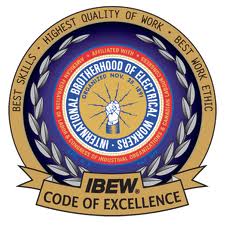Alan Jones, Business Manager
alan_jones@ibew177.org
History and Structure of the IBEW
I B E W® H I S T O R Y
Various histories of labor record no attempts to organize electrical workers during the experimental days of electricity. In 1844 the first telegraph wires were strung between Washington, D.C., and Baltimore carrying that famous message of Samuel Morse, “What hath God wrought?” This was the first electrical accomplishment of commercial importance. It changed the whole aspect of electricity, which most people believed to be an interesting but dangerous experiment. In 1848 the first telegraph station was built in Chicago. By 1861 a web of telegraph lines crisscrossed the United States, and in 1866 the transatlantic cable was laid. Linemen to string the wires became a necessity, and young men flocked eagerly to enter this new and exciting profession.
Opportunity Grows
With Edison’s invention of the first commercially successful incandescent lamp in 1879, the general public became aware of the possibilities of electricity. The electric power and light industry was established with the construction of the Pearl Street Generating Station in New York in 1882. Where once only a few intrepid linemen handled electricity for a thrill, many now appeared on the scene, and wiremen, too, seeking a life’s work. As public demand for electricity increased, the number of electrical workers increased accordingly. The surge toward unionism was born out of their desperate needs
and deplorable safety conditions.
Early Signs of Unity
Beginning in 1870 many small, weak unions organized, then disappeared. However, by 1880 enough telegraph linemen had organized to form their own local assembly and affiliate with the Knights of Labor. A few more locals soon organized, and a district council was formed. In 1883 this council called a general strike against the telegraph companies. The strike failed and broke up the first known attempt to organize electrical workers. The urge to unite was strong, however; and another attempt was made in 1884—this time with a secret organization known as the United Order of Linemen. Headquarters for this union was in Denver, and the group attained considerable success in the western part of theUnited States.
BEGINNING OF BROTHERHOOD
The nucleus of our Brotherhood formed in 1890. An exposition was held in St. Louis that year featuring “a glorious display of electrical wonders.” Wiremen and linemen from all over the United States flocked to Missouri’s queen city to wire the buildings and erect the exhibits which were the “spectaculars” of their era.
The men got together at the end of each long workday and talked about the toil and conditions for workers in the electrical industry. The story was the same everywhere. The work was hard; the hours long; the pay small. It was common for a lineman to risk his life on the high lines 12 hours a day in any kind of weather, seven days a week, for the meager sum of 15 to 20 cents an hour. Two dollars and 50 cents a day were considered an excellent wage for wiremen, and many men were forced to accept work for $8 a week.
There was no apprenticeship training, and safety standards were nonexistent. In some areas, the mortality rate for linemen was one out of every two hired, and nationally the mortality rate for electrical workers was twice that of the national average for all other industries.
No wonder electrical workers of the Gay ’90s sought some recourse for their troubles. A union was the logical answer; so this small group, meeting in St. Louis, sought help from the American Federation of Labor (AFL). An organizer named Charles Cassel was assigned to help them and chartered the group as the Electrical Wiremen and Linemen’s Union, No. 5221, of the AFL.
To Read the Complete History of the IBEW, PLease click the following attachment, provided courtesy of the IBEW
